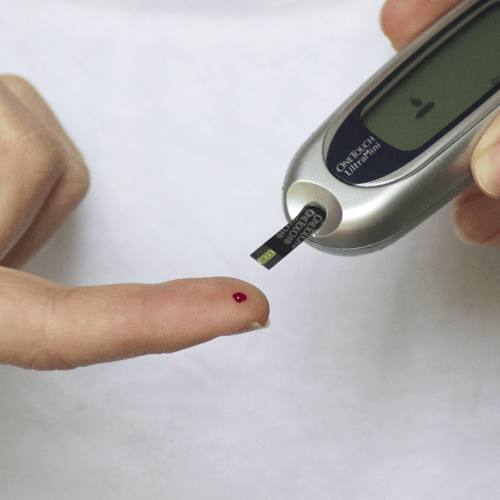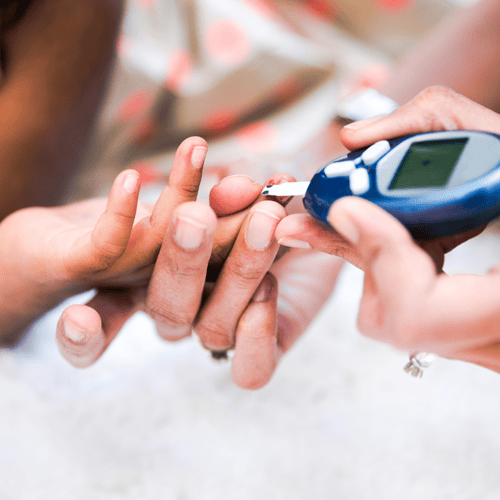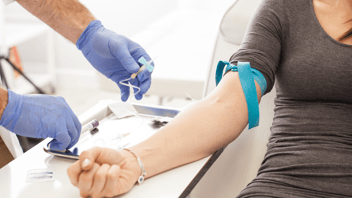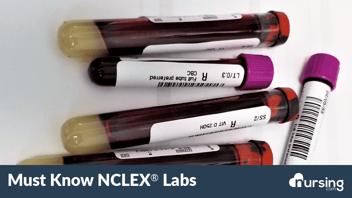20 Lab Values You Must Know To Pass The NCLEX | Nursing School Labs

Must-Know Nursing Lab Values
Nursing NextGen NCLEX Labs Discussed In This Article
|
|
As a nursing student, you know that lab values play a crucial role in patient care. These values provide a snapshot of a patient's overall health and can guide clinical decisions regarding diagnosis and treatment.
As you probably already know . . . with the NextGen NCLEX, you’ll be provided with information on whether a value is normal, low, or high, however, it is still essential that you understand how to interpret these results.
One question I get asked often is what labs should I know for the NextGen NCLEX. If must know NextGen lab values is keeping you up at night, then you’re in luck because, in this article, I will go over 20 lab values that you should know for the NextGen NCLEX. I’ll provide indications, descriptions of the values, and what may cause an increase or decrease in levels.
Alright, let's go!
pH (partial pressure of Hydrogen ion)
Normal Levels for pH (partial pressure of Hydrogen ion):
7.35 - 7.45
Description of pH (partial pressure of Hydrogen ion):
pH reflects the amount of free H+ ions in the body
Indications for pH (partial pressure of Hydrogen ion)
Identifies acidosis or alkalosis in the blood
What would cause increased levels in pH (partial pressure of Hydrogen ion)?
Case study story for increased levels in pH (partial pressure of Hydrogen ion): Sarah, who is feeling anxious and panicky, starts breathing rapidly and deeply due to her heightened stress. This leads to excessive elimination of carbon dioxide (CO2) from her lungs. The decreased levels of carbonic acid (H2CO3) in her blood cause an increase in pH, resulting in respiratory alkalosis.
|
|
What would cause decreased levels in pH (partial pressure of Hydrogen ion)?
Case study example for decreased levels in pH (partial pressure of Hydrogen ion): John, a person with poorly controlled diabetes, experiences a spike in blood sugar levels. The breakdown of fats for energy leads to the production of ketones, causing an increase in hydrogen ions and acidic blood. This results in a decreased pH level known as diabetic ketoacidosis (DKA).
|
Metabolic Acidosis:
|
Respiratory Acidosis:
|
Partial Pressure of CO2 (PaCO2)
Normal Levels for Partial Pressure of CO2 (PaCO2):
35- 45 mmHg
Description of Partial Pressure of CO2 (PaCO2):
Partial Pressure of CO2 (PaCO2) is an indirect measure of gas exchange within the lungs. It measures the pressure of oxygen that is dissolved in plasma. This helps
determine the force of oxygen to diffuse across the membranes in the alveoli. As the PaCO2 increases, the pH of blood becomes acidotic, as PaCO2 decreases, the
pH of the blood becomes alkalotic.
Indications for Partial Pressure of CO2 (PaCO2):
- Reflects the amount of CO2 dissolved in the blood
- Part of Arterial Blood Gas (ABG) testing
What would cause increased levels in Partial Pressure of CO2 (PaCO2):
Case study story for increased levels in Partial Pressure of CO2 (PaCO2): Meet Mark, a middle-aged man with a chronic respiratory disease called emphysema. Due to long-term smoking and exposure to lung-damaging substances, Mark's lung function has significantly deteriorated. As a result of his emphysema, the air sacs in Mark's lungs, called alveoli, lose their elasticity and become damaged. This leads to difficulty exhaling fully, trapping air in his lungs.
- Pulmonary edema
- Chronic Obstructive Pulmonary Disease (COPD):
- Bronchitis
- Emphysema
- Head trauma
- Pickwickian Syndrome
- Over sedation
What would cause decreased levels in Partial Pressure of CO2 (PaCO2):
Case study story for decreased levels in Partial Pressure of CO2 (PaCO2): Meet Michael, who struggles with severe anxiety, and experiences rapid and shallow breathing during anxiety episodes. This hyperventilation causes excessive elimination of CO2 from his lungs, resulting in decreased levels of PaCO2 and respiratory alkalosis. Symptoms include lightheadedness, tingling sensations, and muscle cramps.
- Hyperventilation
- Hypoxemia
- Anxiety
- Pain
- Pregnancy
- Pulmonary Embolism (PE)
Bicarbonate (HCO3)
Normal Levels for Bicarbonate (HCO3):
22-26 mEq/L
Description of Bicarbonate (HCO3):
Bicarbonate (HCO3) is a base and anion that helps to neutralize acids in the blood. Bicarbonate needs to be 20 times the carbonic acid to maintain balance in the
blood. Bicarbonate levels can either be measured or determined using carbon dioxide levels.
Indications for Bicarbonate (HCO3):
Differentiate between metabolic and respiratory causes of pH imbalances.
What would cause increased levels of Bicarbonate (HCO3):
Case study story for increased levels of Bicarbonate (HCO3): Meet Sarah, a middle-aged woman with a history of chronic obstructive pulmonary disease (COPD). COPD has significantly impaired Sarah's lung function, making it difficult for her to exhale fully and causing carbon dioxide (CO2) to accumulate in her blood. Due to the retention of CO2, Sarah develops respiratory acidosis, a condition characterized by increased levels of carbonic acid (H2CO3) in the blood.
What would cause decreased levels of Bicarbonate (HCO3):
Case study story for decreased levels of Bicarbonate (HCO3): Meet Emma, a woman who has been struggling with chronic diarrhea for several weeks. Persistent diarrhea has led to significant fluid and electrolyte loss, including bicarbonate (HCO3-), from her body. As a result of the excessive bicarbonate loss, Emma develops a condition called metabolic acidosis, characterized by decreased levels of bicarbonate in the blood.

Blood Urea Nitrogen (BUN)
Normal Levels for Blood urea nitrogen (BUN):
7-20 mg/dL
Description of Blood urea nitrogen (BUN):
Blood urea nitrogen (BUN) measures the amount of urea in the blood. When protein is broken down ammonia is formed. Ammonia is converted to urea in the liver and is eventually excreted in the kidneys.
Indications for Blood urea nitrogen (BUN):
|
Identifying:
|
Evaluate Effects of Drugs On:
|
Monitor The Effectiveness of Hemodialysis |
What would cause increased levels of Blood urea nitrogen (BUN):
Case study example for increased levels of Blood urea nitrogen (BUN): Meet Jasper, a middle-aged man who has been diagnosed with chronic kidney disease (CKD). CKD is a progressive condition in which the kidneys gradually lose their ability to effectively filter waste products from the blood. As Jasper’s kidney function declines, his kidneys struggle to remove urea, a waste product produced during protein metabolism, from his bloodstream. Urea is normally filtered by the kidneys and excreted in urine, but in renal failure, this process is impaired. As a result, the levels of urea in Jasper’s blood gradually rise, leading to increased levels of blood urea nitrogen (BUN). BUN is a commonly measured laboratory value that indicates the amount of urea in the blood.
What would cause decreased levels of Blood urea nitrogen (BUN):
Case study example decreased levels of Blood urea nitrogen (BUN): Meet Stacey, a woman in her fifties who has been diagnosed with end-stage liver failure. Due to years of chronic liver disease, her liver has progressively lost its ability to function properly. In liver failure, the liver's ability to produce urea, a waste product formed during protein metabolism, becomes compromised. Urea is normally synthesized in the liver and then transported to the kidneys for excretion in the urine. With the decline in liver function, the production of urea is significantly reduced. As a result, Stacey’s (BUN) levels start to decrease.
- Liver Failure
- Overhydration
- Inadequate Protein Intake
- Pregnancy
Cholesterol (Chol)
Normal Levels for Cholesterol (Chol):
<200 mg/dL
Description of Cholesterol (Chol):
Cholesterol (Chol) is a lipid in the body. It is a part of cell membranes as well as a precursor for vitamin D, steroids, and bile acids. Cholesterol is primarily synthesized in the liver and intestines and is transported via lipoproteins. There are multiple types of lipoproteins, each has slightly different functions. The two most common types of lipoproteins are high-density lipoprotein (HDL) and low-density lipoprotein (LDL).
Indications for Cholesterol (Chol):
- Determine the risk of cardiovascular disease
- Evaluate response to treatment
What would cause increased levels of Cholesterol (Chol):
Case study stories for increased levels of Cholesterol: Meet Lisa, a woman in her forties who leads a sedentary lifestyle and consumes a diet high in saturated fats. Over the years, her unhealthy habits contribute to weight gain and an imbalance in her cholesterol levels. As Lisa continues to consume a diet rich in saturated and trans fats, her body begins to produce more cholesterol than it needs.
|
|
What would cause decreased levels of Cholesterol:
Case study stories for decreased levels of Cholesterol: Meet Alex, a young woman who has recently been diagnosed with hyperthyroidism, a condition where the thyroid gland produces an excessive amount of thyroid hormones. As a result of the overactive thyroid gland, Alex's metabolism is accelerated, causing an increase in energy expenditure. This heightened metabolic state affects various aspects of her body's functioning, including her cholesterol levels.
|
|
Glucose (Glu)
Normal Levels for Glucose:
70-115 mg/dL
Description of Glucose:
Glucose is a sugar molecule that is a component of carbohydrates. Glucose provides energy in the body and is absorbed from the blood to the cells for nourishment via insulin. The pancreas secretes insulin to help regulate levels of glucose in the blood. Glucose levels naturally rise after meals with the intake of carbohydrates.
Indications for Glucose:
- Diagnose:
- Hypoglycemia
- Hyperglycemia
- Diabetes Mellitus (DM)
- Monitor treatments for Diabetes Mellitus (DM)
What would cause increased levels of Glucose:
Case study story for increased levels of Glucose: Meet Sarah, a woman in her thirties who has recently been diagnosed with type 2 diabetes. Over the years, her sedentary lifestyle and unhealthy eating habits have taken a toll on her body's ability to regulate blood sugar levels. Due to insulin resistance, Sarah's cells are less responsive to the insulin produced by her pancreas. As a result, glucose is not effectively transported from the bloodstream into the cells, leading to increased levels of glucose in her blood.
|
What would cause decreased levels of Glucose:
Case study story for decreased levels of Glucose: Meet Rachel, a woman in her forties who has recently been diagnosed with insulinoma, a rare tumor of the pancreas that produces excessive amounts of insulin. In Rachel's case, the tumor causes an overproduction of insulin, a hormone that helps regulate glucose levels in the blood. Excessive insulin secretion leads to a rapid uptake of glucose by the body's cells.
|
|
Hematocrit (Hct)
Normal Levels of Hematocrit (Hct):
Male: 41 - 50%
Female: 36 - 44%
Description for Hematocrit (Hct):
Hematocrit (Hct) is the percentage of the blood that is made up of packed Red Blood Cells (RBCs). A hematocrit level of 40% indicates that there are 40 mL packed red blood cells in 100 mL of blood.
Indications for Hematocrit (Hct):
- Identify:
- Anemia
- Bleeding
- Bleeding disorder
- Fluid imbalances
What would cause increased levels of Hematocrit (Hct):
Case study story for increased levels of Hematocrit (Hct): Meet Michael, a professional cyclist who dedicates his life to the sport. Michael has been training rigorously for years, pushing his body to the limits. His intense training regimen has resulted in an adaptation known as "athlete's polycythemia." Through consistent endurance exercise, Michael's body has responded by producing more red blood cells to improve oxygen delivery to his muscles. As a result, his hematocrit levels increase.
|
What would cause decreased levels of Hematocrit (Hct):
Case study story for decreased levels of Hematocrit (Hct): Meet Emma, a woman in her thirties who has been experiencing heavy menstrual bleeding for an extended period. Her excessive menstrual flow has led to iron deficiency anemia. Due to the chronic blood loss, Emma's body becomes depleted of iron, a crucial component for red blood cell production. As a result, her hematocrit levels decrease.
|
|
Hemoglobin (Hbg)
Normal Levels for Hemoglobin (Hbg):
Male: 13.5 - 16.5 g/dL
Female: 12.0 - 15.0 g/dL
Description for Hemoglobin (Hbg):
Hemoglobin (Hbg), an iron-containing compound, is the main protein in Red Blood Cells (RBCs). It enables oxygen and carbon dioxide (CO2) to bind to RBCs for
transport throughout the body.
Indications for Hemoglobin (Hbg):
- Identify
- Bleeding disorders
- Anemia
- Blood loss
What would cause increased levels of Hemoglobin (Hbg):
Case study story for increased levels of Hemoglobin (Hbg): Meet David, a mountaineer who embarks on high-altitude expeditions. Over the years, he has challenged himself to conquer some of the world's highest peaks. David's body has adapted to the high-altitude environment through a process called polycythemia. As David ascends to higher altitudes, the oxygen availability in the air decreases. In response, his body compensates by producing more red blood cells, including hemoglobin, the protein responsible for carrying oxygen in the blood.
|
What would cause decreased levels of Hemoglobin (Hbg):
Case study story for decreased levels of Hemoglobin (Hbg): Meet Lisa, a woman in her forties who has been experiencing chronic kidney disease for some time. The progressive decline in her kidney function has led to a decrease in her hemoglobin levels, a condition known as anemia of chronic kidney disease. The kidneys play a crucial role in producing erythropoietin, a hormone that stimulates the bone marrow to produce red blood cells and hemoglobin. In chronic kidney disease, the impaired kidney function results in reduced erythropoietin production, leading to decreased hemoglobin levels.
|
|
Glycosylated Hemoglobin (HgbA1c)
Normal Levels for Glycosylated Hemoglobin (HbA1c):
5.6-7.5 % of total Hgb
Description of Glycosylated Hemoglobin (HbA1c):
Glycosylated Hemoglobin (HbA1c) is the combination of glucose and hemoglobin. When glucose is elevated in the blood the amount of glycosylated hemoglobin
increases proportionally. A red blood cell's lifespan is about 4 months, so you can get an idea of blood sugar control over the last several months.
Indications for Glycosylated Hemoglobin (HbA1c):
- Assess control of blood sugars over a several-month time frame
- Diagnose Diabetes Mellitus (DM)
What would cause increased levels of Glycosylated Hemoglobin (HbA1c):
Case study story for increased levels of Glycosylated Hemoglobin (HbA1c): Meet Finn, who has been living with uncontrolled type 2 diabetes for several years. Despite regular medical appointments and attempts to manage his condition, Finn struggles to maintain stable blood sugar levels. Over time, his consistently high blood glucose levels have resulted in increased levels of glycosylated hemoglobin, commonly known as HbA1c. HbA1c is a form of hemoglobin that reflects average blood glucose levels over a prolonged period, usually around three months. Finn's elevated HbA1c levels indicate poor long-term blood sugar control.
- Poorly controlled Diabetes Mellitus(DM)
- Non-Diabetic Hyperglycemia
- Stress
- Cushing Syndrome
- Pheochromocytoma
- Corticosteroid Therapy
What would cause decreased levels of Glycosylated Hemoglobin (HbA1c):
- Renal failure
- Blood loss
- Hemolytic anemia
- Sickle cell anemia
Platelets (PLT)
Normal Levels for Platelets (PLT):
100,000 - 450,000 cells/mcL
Description of Platelets (PLT):
Platelets (PLT) play a role in coagulation, hemostasis, and thrombus formation. Platelets are the smallest blood cells, damaged vessels send out signals that result
in platelets traveling to the area and becoming “active”.
Indications for Platelets (PLT):
- Determine clotting vs bleeding disorders
What would cause increased levels for Platelets (PLT):
|
|
What would cause decreased levels of Platelets (PLT):
Case study story for decreased levels of Platelets (PLT): Meet Mark, a 55-year-old man who has recently been diagnosed with immune thrombocytopenia (ITP). ITP is an autoimmune disorder in which the immune system mistakenly attacks and destroys platelets, leading to decreased platelet levels in the bloodstream. Mark's immune system recognizes platelets as foreign objects and launches an attack against them, causing their destruction and reducing the overall platelet count. With decreased platelet levels, Mark is at an increased risk of bleeding and bruising.
|
|
|
|
Potassium (K+)
Normal Levels for Potassium (K+):
3.5 - 5.0 mEq/L
Description of Potassium (K+):
Potassium (K+) is the most abundant intracellular cation and plays a vital role in the transmission of electrical impulses in cardiac and skeletal muscle. It plays a
role in acid-base equilibrium. In states of acidosis, hydrogen will enter the cell which will force potassium out of the cell. A 0.1 decrease in pH will cause a 0.5
increase in K+.
Indications for Potassium (K+):
|
|
What would cause increased levels of Potassium (K+):
Case study story for increased levels of Potassium (K+): Meet John, a 50-year-old man who has recently been diagnosed with acute kidney injury. Due to a sudden decrease in his kidney function, John's body is unable to effectively excrete excess potassium from his bloodstream. As a result, John's potassium levels begin to rise.
|
|
|
|
What would cause decreased levels of Potassium (K+):
Case study story for decreased levels of Potassium (K+): Meet Emily, a 20-year-old woman who has been living with cystic fibrosis since birth. Cystic fibrosis is a genetic disorder that primarily affects the lungs and digestive system. However, it can also impact other parts of the body, including the kidneys. Due to the effects of cystic fibrosis on the kidneys, Emily experiences abnormal electrolyte levels, including decreased levels of potassium, a condition known as hypokalemia.
|
|
Sodium (Na+)
Normal Levels for Sodium (Na+):
135-145 mEq/L
Description of Sodium (Na+):
Sodium (Na+) is the most abundant cation in extracellular fluid. Sodium aids in osmotic pressure, renal retention and excretion of water, acid-base balance, and regulation of other cations and anions in the body. Sodium plays a role in blood pressure regulation and stimulation of neuromuscular reactions. Sodium and water have a direct relationship; water follows salt.
Indications for Sodium (Na+):
- Monitor
- Extracellular osmolality
- Electrolyte imbalance
What would cause increased levels of Sodium (Na+):
Case study story for increased levels of Sodium (Na+): Meet David, a 30-year-old man who has recently suffered a severe burn injury in a workplace accident. Burn injuries can lead to a variety of physiological changes in the body, including alterations in electrolyte levels. After the burn injury, David's body initiates a stress response that triggers the release of stress hormones, such as cortisol. These hormones, in turn, affect the regulation of sodium in the body.
|
|
|
What would cause decreased levels for Sodium (Na+):
Case study story for decreased levels of Sodium (Na+): Meet Lisa, a 25-year-old woman who experiences recurrent episodes of vomiting due to an underlying gastrointestinal condition. Frequent vomiting can lead to significant fluid and electrolyte imbalances in the body. One of the electrolytes that can be affected by vomiting is sodium.
|
|
|
White Blood Cell (WBC)
Normal Levels for White blood cells (WBCs):
4,500 - 10,000 cells/mcL
Description of White blood cells (WBCs):
White blood cells (WBCs) are created in the bone marrow. Their primary function is to defend the body against infection. There are various types of WBCs that
have different shapes and functions. Decreased WBC count is called Leukopenia and increased WBC count is called Leukocytosis.
Indications for White blood cells (WBCs):
- Evaluate for infection
What would cause increased levels of White blood cells (WBCs):
Case study story for increased levels of White blood cells (WBCs): Meet Sarah, a 60-year-old woman who recently underwent a surgical procedure to remove a tumor from her abdomen. Unfortunately, due to complications during the surgery, a portion of the surrounding tissue experienced necrosis, or cell death. As a response to tissue necrosis, Sarah's body activates its immune system to clear away the dead cells and prevent infection. One of the immune system's primary defenses is the production and release of white blood cells. In response to the tissue necrosis, Sarah's body increases the production and release of white blood cells.
|
What would cause decreased levels of White blood cells (WBCs):
Case study story for decreased levels of White blood cells (WBCs): Meet Michael, a 45-year-old man who has been living with rheumatoid arthritis for several years. Rheumatoid arthritis is an autoimmune condition characterized by chronic inflammation in the joints, causing pain, swelling, and stiffness. Over time, the chronic inflammation associated with rheumatoid arthritis can suppress the bone marrow's ability to produce an adequate number of white blood cells, leading to decreased levels in the bloodstream.
|
|
Creatinine (Cr)
Normal Levels for Creatinine (Cr):
0.7-1.4 mg/dL
Description of Creatinine (Cr):
Creatinine (Cr) is a byproduct of creatine metabolism, and it is excreted by the kidneys. Creatinine is created in proportion to muscle mass and usually stays stable.
Indications for Creatinine (Cr):
- Identify
- Muscular disorders
- Renal disease
What would cause increased levels of Creatinine (Cr):
Case study story for increased levels of Creatinine (Cr): Meet Alex, a 40-year-old man who has been involved in a severe car accident. The impact of the accident resulted in significant blood loss and trauma to his body. As a result, Alex goes into a state of shock. Shock is a life-threatening condition that occurs when the body's vital organs do not receive enough oxygen and nutrients. In response to the shock, the kidneys experienced decreased blood flow. When the kidneys receive an inadequate blood supply, they struggle to filter waste products effectively, such as creatinine. As a consequence, the levels of creatinine in Alex's bloodstream begin to rise.
|
|
What would cause decreased levels of Creatinine (Cr):
Case study story for decreased levels of Creatinine (Cr): Meet Lisa, a 60-year-old woman who has been bedridden for several months due to a prolonged illness. During this time, she experiences significant muscle wasting and loss of muscle mass, a condition known as muscle atrophy. Creatinine is primarily produced by muscle metabolism, and its levels in the bloodstream are influenced by muscle mass. As Lisa's muscle mass decreases, there is a corresponding decrease in the production of creatinine. As a result, Lisa's creatinine levels in her bloodstream begin to decline.
|
|
Prothrombin Time (PT)
Normal Levels for Prothrombin Time (PT):
11 - 14 seconds
Description of Prothrombin Time (PT):
Prothrombin Time (PT) measures the time it takes for a fibrin clot to form. PT monitors the clotting ability of factors I, II, V, VII, IX, and X. Prothrombin is produced by the liver and is dependent on vitamin K. Prothrombin Time is used to monitor Warfarin (Coumadin) therapy.
Indications for Prothrombin Time (PT):
- Monitoring Warfarin (Coumadin) therapeutic levels(PTT for Heparin)
- Identify
- Patients at higher risk for bleeding
- Cause of bleeding
- Deficiencies
What would cause increased levels of Prothrombin Time (PT):
|
|
What would cause decreased levels of Prothrombin Time (PT):
|
|
Partial Thromboplastin Time (PTT)
Normal Levels for Partial Thromboplastin Time (PTT):
25 - 35 seconds
Description of Partial Thromboplastin Time (PTT):
Partial Thromboplastin Time (PTT) evaluates the function of factors I, II, V, VIII, IX, X, XI, and XII. PTT represents the amount of time required for a fibrin clot to form.
Monitors therapeutic ranges for people taking Heparin.
Indications for Partial Thromboplastin Time (PTT):
- Detection of coagulation disorders
- Evaluate response to Heparin (PT for Coumadin)
- Preoperative assessment
What would cause increased levels in Partial Thromboplastin Time (PTT):
|
|
What would cause decreased levels in Partial Thromboplastin Time (PTT):
- N/A
International Normalized Ratio (INR)
Normal Levels for International normalized ratio(INR):
0.8 - 1.2
Therapeutic Levels of Warfarin 2.0 – 3.5
Description of International normalized ratio(INR):
International normalized ratio(INR) takes results from a prothrombin time test and standardizes it regardless of the collection method.
Indications for International normalized ratio(INR):
- Evaluate therapeutic doses of Warfarin
- Identify patients at higher risk for bleeding
- Identify cause of
- Bleeding
- Deficiencies
What would cause increased levels in International normalized ratio(INR):
- Disseminated Intravascular Coagulation (DIC)
- Liver disease
- Vitamin K deficiency
- Warfarin
What would cause decreased levels in International normalized ratio(INR):
- Too much vitamin K
- Estrogen-containing medications such as birth control
Calcium (Ca2+)
Normal Levels for Calcium (Ca+):
8.4-10.2 mg/dL
Description of Calcium (Ca+):
Calcium (Ca+), a positive ion in the body, is necessary for neuromuscular processes, bone mineralization, and hormonal secretion. The parathyroid gland and vitamin
D is responsible for calcium regulation in the body. In the blood, about half of calcium travels in ion form, the other half is bound to proteins like albumin. When
albumin levels are low, calcium levels will appear lower. Calcium has an important relationship with phosphorus: they are inversely proportional.
Indications for Calcium (Ca+):
- Identify problems with
- Parathyroid
- Neuromuscular functions
- Diseases that affect bone
- Effectiveness of treatments
What would cause increased levels in Calcium (Ca+):
Case study story for increased levels in Calcium (Ca+): Meet Sarah, a 55-year-old woman who has recently been diagnosed with advanced breast cancer that has spread to her bones. Breast cancer, like several other types of cancer, can cause abnormalities in calcium metabolism.
|
|
What would cause decreased levels of Calcium (Ca+):
Case study story for decreased levels of Calcium (Ca+): Meet Mark, a 40-year-old man who has been struggling with alcoholism for several years. Chronic alcohol abuse can have detrimental effects on multiple organ systems, including the liver and the kidneys, which play a crucial role in calcium homeostasis.
|
|
|
Chloride (Cl-)
Normal Levels for Chloride (Cl-):
96-108 mEq/L
Description of Chloride (Cl-):
Chloride (Cl-), an anion found in the blood, works together with sodium to help maintain oncotic pressure and water balance in the body. Chloride is inversely
related to bicarbonate levels in the blood. Chloride is also part of hydrochloric acid (HCL) which is utilized in the stomach to breakdown food. When red blood cells
(RBCs) take up CO2 they take up chloride as well. The negative ion bicarbonate then leaves the red blood cell so that the electrical charge is maintained. Extra
chloride is excreted into the urine by the kidneys.
Indications for Chloride (Cl-):
- Identify Acid-Base Imbalance
What would cause increased levels in Chloride (Cl-):
- Dehydration
- Acute Renal Failure
- Cushing Disease
- Metabolic Acidosis
- Respiratory Alkalosis
What would cause decreased levels in Chloride (Cl-):
|
|
Red Blood Cell (RBC)
Normal Levels for Red Blood Cells (RBCs):
Male: 4.5 - 5.5 x106/cells/mm3
Female: 4.0 - 4.9 x106/cells/mm3
Description of Red Blood Cells (RBCs):
Red Blood Cells (RBCs) contain hemoglobin which is responsible for oxygen transport throughout the body. RBCs are primarily produced in the bone marrow, they
have a lifespan of 120 days and are destroyed in the spleen and liver. RBC production is regulated by erythropoietin (EPO), which is produced and released from
the kidneys.
Indications for Red Blood Cells (RBCs):
- Identify
- Anemia
- Blood loss
What would cause increased levels in Red Blood Cells (RBCs):
Case study story for increased levels in Red Blood Cells (RBCs): Meet Alex, an adventurous mountaineer who decides to embark on a challenging expedition to climb Mount Everest, the tallest peak in the world. As Alex ascends to higher altitudes, he experiences a decrease in oxygen levels in the atmosphere. In response to hypoxia, Alex's body initiates a compensatory mechanism to deliver more oxygen to the tissues. One of the ways the body adapts to decreased oxygen availability is by increasing the production of red blood cells.
|
|
What would cause decreased levels in Red Blood Cells (RBCs):
Case study story for decreased levels in Red Blood Cells (RBCs): Meet Emily, a 30-year-old woman who is excitedly expecting her first child. During pregnancy, a woman's body undergoes various physiological changes to support the growing fetus. One of these changes involves an increase in blood plasma volume, which occurs more rapidly than the increase in red blood cell production. As a result, the concentration of red blood cells in Emily's bloodstream decreases
|
|
|
|
That's it! You made it through 20 must-know labs for the NextGen NCLEX!
If you are like me, when I picked up that 1800-page Davis lab book, I had a sudden panic attack . . . how was I going to learn ALL of those lab values? It would literally take months and months!
Guess what? I didn’t . . . and I still haven’t!
You might be thinking . . . what the heck did you do then, Jon? Let me tell you!
I came up with a list . . . how’d I come up with this list?
I took TONs of notes… I started writing down every lab value that I would continually see in clinicals or as a new nurse. In addition, I would write down those common lab values that I would see on exams as a nursing student.
That list turned out to be 63 lab values.
You CAN do this.
Happy Nursing!





















.png?width=500&height=500&name=nursing%20labs%20(2).png)

.png?width=500&height=500&name=labs%20for%20nursing%20students%20(2).png)






.png?width=500&height=500&name=normal%20lab%20values%20nursing%20(2).png)


